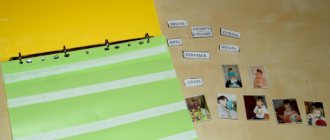Psychological features of speech development in preschool children November 2022
Psychological features of speech development in preschool children
Preschool age is a period of active acquisition of spoken language by a child, the formation and development of all aspects of speech. The sooner learning the native language begins, the more freely the child will use it in the future.
In preschool children, speech has an important influence on the development of sensations and perceptions and contributes to the formation of thinking. Thanks to speech, ideas about the world around us develop and memory improves.
As the lexico-grammatical side of speech develops, the child masters such intellectual operations as comparison, analysis and synthesis.
Speech is one of the indicators of child development. Speech accompanies all types of activity.
It fulfills several needs of the child: communicative, informative, cognitive (developmental), which already speaks of its great significance.
The primary function of speech is communicative. Without the development of speech, full communication of a person in society is impossible. Language development is at the center of a child's learning.
Work on the development of children's speech must be comprehensive and solve problems associated with all aspects of speech development - phonemic, lexical, grammatical. A comprehensive influence on a child’s speech is a prerequisite for the development of coherent speech. In addition, it is the adult who awakens the child’s interest in language and encourages him to be creative.
Timely and complete development of speech in preschool age is one of the main conditions for the normal development of a child and his subsequent successful education at school. Modern means started from the first days of a child’s life. Comprehensive means a sufficient amount of language material, encouraging the child to master speech to the best of his ability at each age level.
Any delay and any disturbance in the development of a child’s speech is reflected in his behavior, as well as his activity in its various forms.
Speech is not an innate ability, but develops in the process of ontogenesis (individual development of the body from the moment of its inception to the end of life.) in parallel with the physical and mental development of the child and serves as an indicator of his overall development. A child’s acquisition of his native language follows a strict pattern and is characterized by a number of features common to all children. In order to understand speech pathology, it is necessary to clearly understand the entire path of sequential speech development of children in normal conditions, to know the patterns of this process and the conditions on which its successful occurrence depends.
In addition, you need to clearly imagine each stage of the child’s speech development, each “qualitative leap” in order to notice in time certain deviations in this process. For example, a baby is 1 year 4 months. doesn't speak yet. The teacher can decide whether this phenomenon is normal or not only if he knows when, during normal development, the first words should appear.
Knowledge of the patterns of speech development in children is also necessary for the correct diagnosis of speech disorders. Thus, some experts sometimes refer three-year-old children to a speech therapist to eliminate deficiencies in the pronunciation of sounds. Is it correct? No. Because even with normal speech development, a child at a given age is “supposed” to pronounce some sounds incorrectly. This phenomenon, called physiological tongue-tiedness, is completely natural and is due to the still insufficient formation of the articulatory apparatus.
And finally, knowledge of the laws of development of children’s speech in the process of ontogenesis is also necessary in order to correctly construct all correctional and educational work to overcome speech pathology. For example, when teaching non-speaking children (alaliks), it is very important to know that first every child develops an understanding of speech and only then does he master active speech. Consequently, if in this case you immediately develop active speech, the work will not bring the desired effect.
A. N. Leontyev establishes four stages in the development of children’s speech:
1st - preparatory - up to one year;
2nd - pre-preschool stage of initial language acquisition - up to 3 years;
3rd - preschool - up to 7 years;
4th - school.
Let us dwell in detail on the characteristics of these stages.
So, the first stage is preparatory (from the moment the child is born to one year).
Why is this stage called this? Because at this time preparation for mastering speech occurs. What is it?
From the moment of birth, the child develops vocal reactions: screaming and crying. True, they are still very far from the sounds of human speech. However, both screaming and crying contribute to the development of subtle and varied movements of the three sections of the speech apparatus: respiratory, vocal, articulatory.
After two weeks, you can already notice that the child begins to respond to the speaker’s voice: he stops crying, listens when he is addressed. By the end of the first month, he can already be calmed down with a melodic song (lullaby). Next, he begins to turn his head towards the speaker or follow him with his eyes. Soon the baby already reacts to intonation: to a gentle one he becomes animated, to a harsh one he cries.
About 2 months humming appears and by the beginning of the 3rd month. - babble (agu-huh, cha-cha, ba-ba, etc.). Babbling is a combination of sounds that are vaguely articulated.
From 5 months the child hears sounds, sees articulatory movements of the lips of others and tries to imitate. Repeated repetition of a specific movement leads to consolidation of a motor skill.
From 6 months The child pronounces individual syllables by imitation (ma-ma-ma, ba-ba-ba, cha-cha-cha, pa-pa-pa, etc.).
Subsequently, through imitation, the child gradually adopts all the elements of spoken speech: not only phonemes, but also tone, tempo, rhythm, melody, intonation.
In the second half of the year, the baby perceives certain sound combinations and associates them with objects or actions (tick-tock, give-give, bang). But at this time he still reacts to the entire complex of influences: the situation, intonation and words. All this helps the formation of temporary connections (memorizing words and reacting to them).
At the age of 7 - 9 months. the child begins to repeat more and more diverse combinations of sounds after the adult.
From 10 - 11 months. reactions to the words themselves appear (regardless of the situation and intonation of the speaker).
At this time, the conditions in which the child’s speech is formed (correct speech of others, imitation of adults, etc.) become especially important.
By the end of the first year of life, the first words appear.
The second stage is pre-preschool (from 1 year to 3 years).
With the appearance of the child’s first words, the preparatory stage ends and the stage of development of active speech begins. At this time, the child develops special attention to the articulation of those around him. He very much and willingly repeats after the speaker and pronounces the words himself. At the same time, the baby confuses sounds, rearranges them, distorts them, and omits them.
The child’s first words are of a generalized semantic nature. With the same word or sound combination it can denote an object, a request, or feelings.
- For example, the word porridge can mean porridge at different moments; give me some porridge; hot porridge.
- Or the word papa can mean papa came; no dad; dad, come over, etc.
It is possible to understand a child only in a situation in which or about which his communication with an adult takes place. Therefore, such speech is called situational. The child accompanies situational speech with gestures and facial expressions.
From the age of one and a half years, the word acquires a generalized character. It becomes possible to understand an adult’s verbal explanation, assimilate knowledge, and accumulate new words.
During the 2nd and 3rd years of life, the child experiences a significant accumulation of vocabulary.
It should be noted that various researchers (both ours, domestic and foreign) provide different quantitative data on the growth of children’s vocabulary.
Let us present the most common data on the rapid development of children's vocabulary in the preschool period: by 1 year 6 months. - 10 - 15 words; by the end of the 2nd year - 300 words (in 6 months about 300 words!); by year 3 - about 1000 words (i.e. about 700 words per year!).
The meanings of words become more and more defined.
By the beginning of the 3rd year of life, the grammatical structure of speech begins to form in the child.
First, the child expresses his desires and requests in one word. Then - in primitive phrases without agreement (“Mom, give Tata something to drink” - Mom, let Tata drink some milk). Next, elements of coordination and subordination of words in the sentence gradually appear.
The third stage is preschool (from 3 to 7 years).
At the preschool stage, most children still have incorrect sound pronunciation. You can detect defects in the pronunciation of whistling, hissing, sonorant sounds r and l, and less often - defects in softening, voicing and iotation.
Over the period from 3 to 7 years, the child increasingly develops the skill of auditory control over his own pronunciation, the ability to correct it in some possible cases. In other words, phonemic perception is formed.
During this period, the rapid increase in vocabulary continues. By the age of 4–6 years, a child’s active vocabulary reaches 3000–4000 words. The meanings of words are further clarified and enriched in many ways. But often children still misunderstand or use words, for example, by analogy with the purpose of objects, they say “pour” instead of watering from a watering can, “dig” instead of a shovel, etc. At the same time, this phenomenon indicates a “sense of language.” This means that the child’s experience of verbal communication grows and on its basis a sense of language and the ability to create words are formed.
K. D. Ushinsky attached special importance to the sense of language, which, according to him, tells the child the place of emphasis in a word, grammatical expression, and the way of combining words in a sentence.
In parallel with the development of vocabulary, the development of the grammatical structure of speech also occurs. During the preschool period, children master coherent speech. After three years, the content of the child’s speech becomes significantly more complex and its volume increases. Children of the 4th year of life use simple and complex sentences in speech. The most common form of statements at this age is a simple common sentence (“I dressed the doll in such a beautiful dress”; “I will become a big strong uncle”).
At the age of 4-5 years, when the child already has a good command of speech and can talk with an adult on abstract topics, non-situational-cognitive communication becomes possible. The child acquires a sufficient vocabulary and begins to construct phrases grammatically correctly and pronounce sounds normally. The active vocabulary that a child has at the age of 4 gives him the opportunity to freely communicate with others. But he often experiences difficulties due to the insufficiency and poverty of the vocabulary when he needs to convey an event in which he himself was a participant. Here the baby often makes inaccuracies. In the process of mastering new words, the child not only memorizes them, he begins to comprehend their sound side, tries to establish a closer connection between the object and the word denoting it, strives in his own way to understand the names of certain objects, actions, i.e. The child develops a motivated attitude towards vocabulary. At this age, the child is not yet able to independently talk logically, coherently and clearly for others about the events he witnessed; he cannot intelligently retell the content of a fairy tale or story read to him. His speech is still situational. The child’s utterances consist of simple common sentences, often only distantly related in content. It is not always possible to understand their content without additional questions. There is still no development in the utterance that is characteristic of monologue speech.
At 5 years of age, children are relatively fluent in using the structure of compound and complex sentences (“Then, when we went home, they gave us gifts: various candies, apples, oranges”; “Some smart and cunning guy bought balloons, made candles, threw into the sky, and it turned out to be a fireworks display").
Starting at this age, children's statements resemble a short story. During conversations, their answers to questions include more and more sentences.
At the age of five, children, without additional questions, compose a retelling of a fairy tale (story) of 40 - 50 sentences, which indicates success in mastering one of the difficult types of speech - monologue speech.
During this period, phonemic perception improves significantly: first, the child begins to differentiate vowels and consonants, then soft and hard consonants, and finally, sonorant, hissing and whistling sounds.
By the age of 4, a child should normally differentiate all sounds.
that is, he must have developed phonemic perception.
By this time, the formation of correct sound pronunciation ends and the child speaks completely clearly.
During the preschool period, contextual (abstract, generalized, devoid of visual support) speech is gradually formed. Contextual speech appears first when the child retells fairy tales and stories, then when describing some events from his personal experience, his own experiences, impressions.
Having a good memory, a child is able to remember and reproduce short poems, and after listening to the same fairy tale repeatedly, he can convey its content almost word for word, often without even understanding the meaning of the words.
Normal (timely and correct) speech development of a child allows him to constantly learn new concepts, expand his stock of knowledge and ideas about the environment. Thus, speech and its development are most closely related to the development of thinking.
Thus, preschool childhood is a period of intensive development of communicative forms and functions of language activity, practical speech skills, and awareness of speech activity.
The following types of disorders occur in preschool age:
— DYSPHONIA / APHONIA / - absence or disorder of phonation due to pathological changes in the vocal apparatus. They manifest themselves in the absence or violation of the strength, pitch, and timbre of the voice.
— BRADYLALIA is a pathologically slow rate of speech.
- TACHILALIA - pathologically accelerated rate of speech.
— STUTTERING is a violation of the tempo-rhythmic organization of speech, caused by the convulsive state of the muscles of the speech apparatus.
-DYSLALIA is a violation of sound pronunciation with normal hearing and intact innervation of the speech apparatus.
— DYSARTHRIA - a violation of sound pronunciation caused by insufficient innervation of the speech apparatus. (organic)
— RINOLALIA - a violation of sound pronunciation and timbre of the voice, caused by anatomical and physiological defects of the speech apparatus.
- ALALIA - absence or underdevelopment of speech due to organic damage to the cerebral cortex in prenatal or early periods of development.
— DELAYED SPEECH DEVELOPMENT (RDD) - the slowest rate of mastery of the native language compared to the norm.
— PHONETIC-PHONEMATIC UNDERDEVELOPMENT (FFN) is a violation of the processes of formation of the pronunciation aspect of the native language in children with various speech disorders associated with defects in the perception and pronunciation of sounds.
— GENERAL SPEECH IMPORTANCE (GND) is a complex speech disorder in which children have impaired formation of all components of speech (vocabulary, grammar, phonetics, semantics) with normal hearing and intelligence.
Each group of defects differs in form and degree of severity. The nature of correctional work, forms and methods, as well as timing depend on this.
It is also necessary to touch upon such an important element as the prevention of speech disorders. If it is not carried out, then transitions of certain disorders to written speech (DYGRAPHIA, DYSLEXIA) or layering of secondary disorders on primary ones are possible. And this is an even more complex correction process. Therefore, it is advisable to eliminate all speech disorders in preschool age.
Conclusion on Chapter I
From the very first days of life until the end of the preschool period, children have the most important task - the formation and development of speech. Each year of a child’s life is divided into stages and at each of them speech is improved - from the first infant cry to the composition of complex sentences.
During early childhood, children undergo intensive speech development. During this time, the child’s active vocabulary exceeds the passive one; the child learns that each object has its own name; after he hears the word, he tries to repeat it; he learns to compose simple and complex common sentences.
The development of a child’s speech is closely related to communication with adults, and a lack of this communication can lead to delayed speech development and also affect the development of the baby’s psyche. A child’s communication with the people around him allows him to increase his passive and active vocabulary, improve his pronunciation and the content of his speech.
Conclusion on chapter 2
The most effective method of developing the speech of a young child is his participation in various types of activities.
Productive activities (appliqué, modeling, drawing) form a child’s idea of the shape, color or properties of a particular object. During the lessons, the child develops imagination, fine motor skills and, most importantly, speech activity. The child discovers a lot of new things and wants to know about everything, this is how the child’s dialogue with an adult or teacher is formed.
Playful activities allow the child to improve not only the coordination of movements while playing with objects, but also the quality and quantity of words in his active vocabulary, as the child gives a name to the object/toy, comes up with a situation in which he is and explains his actions. Thus, we can say that play is a fruitful way to develop speech in children.
All the methods we propose contribute to the development and improvement of the child’s speech, and also help prevent its delay.







